【CK's Geometry Talks】 Page
Created May 30, 2023
![]()
Created May 30, 2023
![]()
This page has all the lectures on elementary geometry and related topics,
and will be updated when new lectures will become available.
Why do I make these video lectures?
I don't know the answer or answers for sure.
When I was in high school, I loved geometry
because I had a great geometry teacher who was so capable of inspiring students
even though he was very tough.
From whatever I learned in his class and my exploration outside of the class,
I started to enjoy the beauty of geometry and my exploration was very fruitful.
Before I graduted from high school,
I wrote an article for the school's annual
Must the angle sum of a triangle be 180 degree?
and an article for the 20-th aniversary special issue of the high school
Transformation Groups and Geometries: Klein's Erlangen Program.
When I was an undergrad in Math,
I published a paper The Triangle Area Formula Implies the Parallel Postulate in MAA's Mathematics Magazine.
So, I am interested in geometry for sure.
However, after receiving my BS degree my interests shifted to computer science
and what brought me back to geometry was a few YouTube videos
and the Japanese Temple Geometry Problems.
Japanese Temple Geometry refers to the practice of carving or writing
geometrical problems, theorems, and some other results on wooden tablets,
usually in a verbal way,
and presenting them as an offering at a temple or shrine.
The problems on these tablets are usually referred to as
Japanese Temple Geometry Problems.
The image below is an example.
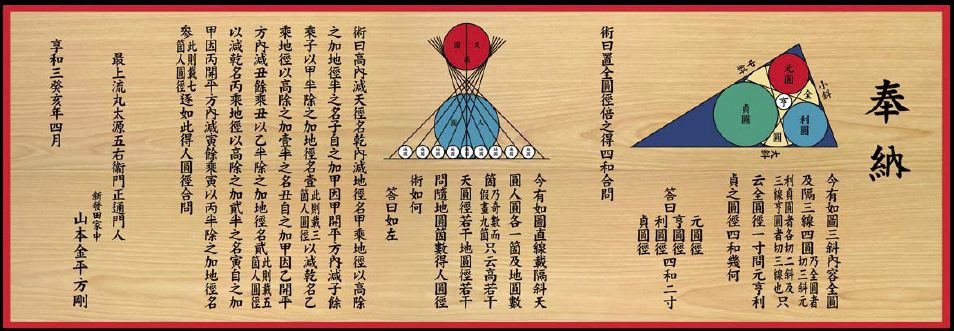
The book by Hidetoshi Fukagawa and Dan Pedoe, Japanse Temple Geometry Problems (San Gaku) (below left), was the first book in which many problems were collected and discussed. Later, Hidetoshi Fukagawa and Tony Rothman published another comprehensive book, Sacred Mathematics: Japanese Temple Geometry (below right), in which many problems were explained along with a detailed history account.
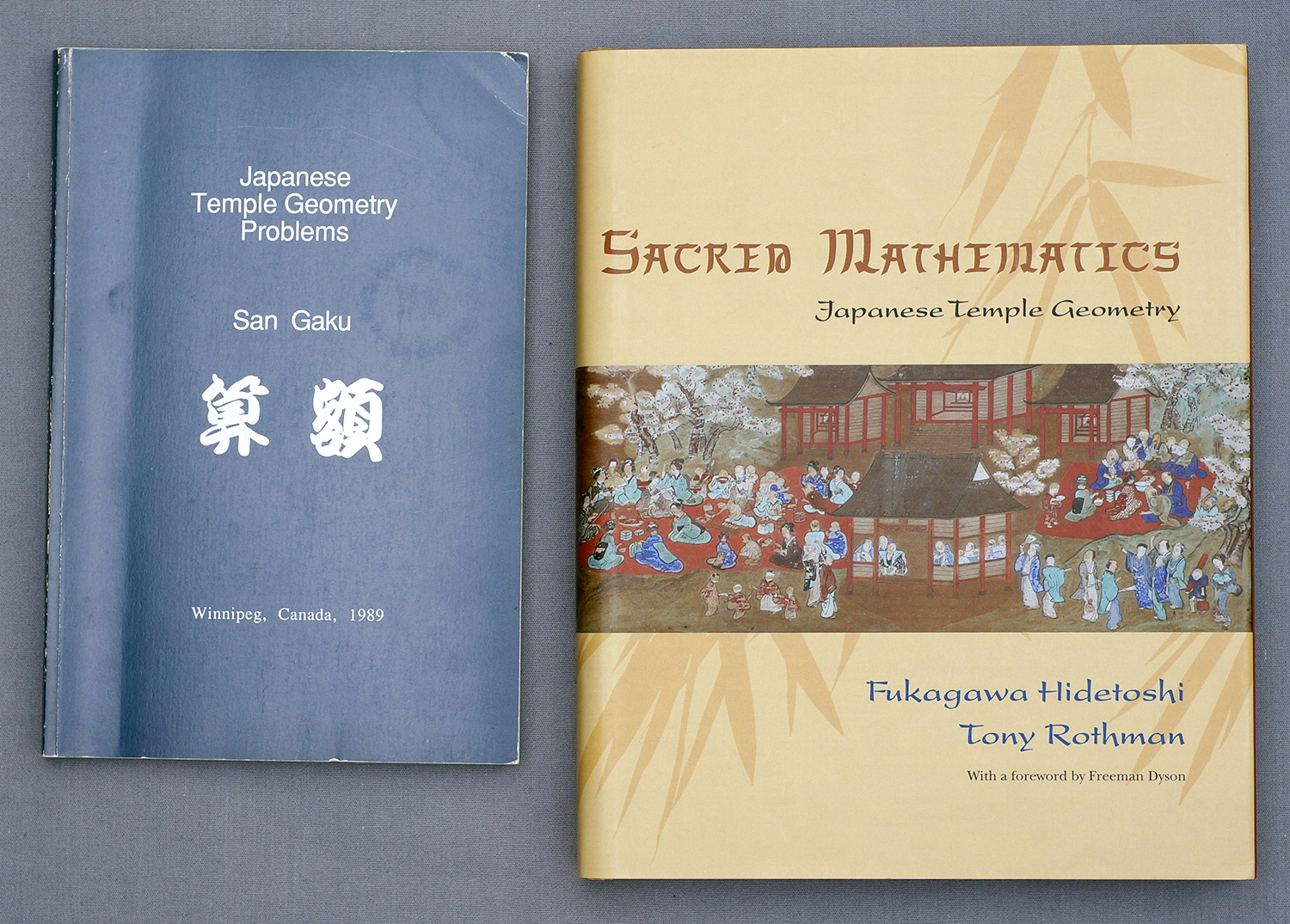
In the 2023 Spring months, while browsing YouTube for something for my own research, a few videos discussing the Japanese Temple Geometry problems were found. Because I knew the topics, I watched nearly all of them with great interests. However, I found that some videos did discuss one or two Japanese Temple Geometry problems, while some others failed to address the problem properly. Moreover, some even incorrectly identified the Japanese Temple Geometry problems. Because I have the two definitive books and read many related papers, I believe I could do a better job in explaning these Japanese Temple Geometry problems with rigor. This was my initial thought of making my own videos. Then, in the planning stage I realized that I could do more by
There are many possible topics and the above only named a few.
Please note that these videos are purely work based on my personal interests. I did not receive anything from YouTube and elsewhere. A big "like" 👍 is very much appreciated.
Thank you!
| No. | Content | Videos | Slides | Notes | Date |
| 1 | Given two circles of equal radius that are tangent to each other externally,
if they are both tangent to the hypotenuse of a right triangle
and each is tangent to one of the other sides,
find the radius in terms of the side lengths:
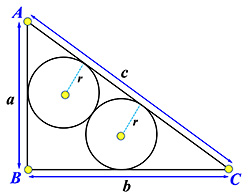
|
A Simple Japanese-Temple-Geometry- Problems like Problem | Slides | Lecture Notes | April 8, 2023 |
| 2 | What if the two equal radius circles are tangent one of the two non-hypotenuse sides?
Find the radius in terms of the side lengths:
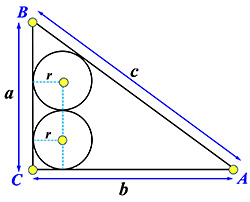
What if the given triangle is an arbitrary triangle? In this case, the two equal radius circles are tangent to one of the three sides and each of the circle is tangent to one of the other sides.
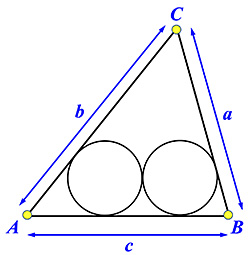
|
A Variation and A Generalization of the Problem in EP1 | Slides | April 19, 2023 | |
| 3 | This lecture focuses on two seemingly unrelated sets of problems
and shows that they are actually very closely related.
The first set of problems has two circles that are tangent to each other
and tangent to a fixed line.
What is the radius of the circle, say C1,
that is tangent to the two given circles and the given line?
Let one of the two given circles be A.
Then, circle A and circle C1
determine another circle C2 in the same way.
What is the radius of this circle C2?
This process is able to produce an infinite number of circles
C1, C2,
C3, ..., Cn.
What is the radius of circle Cn
in terms of the two given circles?
The first set of problems addresses this question.
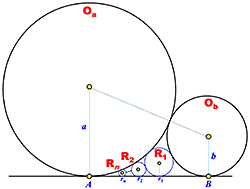
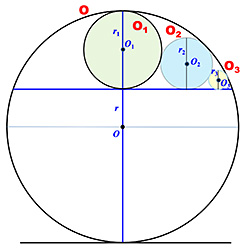
|
Seven Japanese Temple Geometry Problems | Slides | Lecture Notes | July 23, 2023 |
| 4 | This is the first talk on the Pythagorean Theorem and the Pythagorean Identity.
Elisha Scott Loomis made an incorrect claim in his well-kown book,
"Pythagorean Proposition' published in 1907,
that the Pythagorean Theorem cannot be proved by trigonometric techniques
because the fundamental identity (i.e., the Pythagorean Identify
in today's terminology) depends on the Pythagorean Theorem.
Therefore, proving the Pythagorean Theorem using trigonometry
could be in a circular reasoning.
This claim/reasoning is WRONG! This is the first lecture of a 3-episode series. We shall prove that the Pythagorean Identity can be proved without using the Pythagorean Theorem. In fact, we shall show that the angle difference and angle sum identities are independent of the Pytagorean Theorem and the Pythagorean Identity. Then, the angle difference identity implies the Pythagorean Identity immediately. We also prove that the derivative computation of sin(x) and cos(x) are also independent of the Pythagorean Theorem and the Pythagorean identiy, and show that the double angle identities, which are direct consequences of the angle sum identities, implies the Pythagorean Identity. Consequently, we proved that Loomis was wrong!
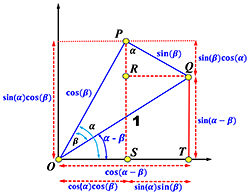
The next two lectures will focus on possible new proving techniques and the proof by Jaskson and Johnson presented in early 2023. Why is Jackson-Johnson proof important? This is because their proof was claimed to be an impossible proof as their used trigonometry. We will show in the third episode of this series that the use of trigonometry in the proof of Jackson and Johnson can be eliminated completely with the new technique. | The Pythagorean Theorem I | Slides | Lecture Notes | October 31, 2023 |
| 5 | This is the second talk on the Pythagorean Theorem and the Pythagorean Identity.
This lecture discusses a new method of computing the length of a line segment
and the area of a shape based on similarity.
With the help of this new method, we are able to re-prove some proofs discussed
in Lommis book.
Additionally, by using the Lemoine/Grebe/Symmedian point and one of its many
interesting properties we are able to provide a possibly new proof.
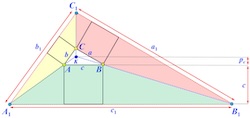
The next (and actually last) lecture, we will discuss the proof by Jackson and Johnson. |
The Pythagorean Theorem II | Slides | November 30, 2023 | |
| 6 | This is the third talk on the Pythagorean Theorem and the Pythagorean Identity.
This lecture discusses a pure geometric proof based on the 2023 proof of Jackson and Johnson.
Note that the proof of Jackson and Johnson used trigonometry,
which according to Lommis is impossible.
After presenting this pure geometric prrof,
the original trigonomatry based proof is discussed.
Therefore, the trigonometric component used in Jackson-Johnson's proof
can easily be eliminated.
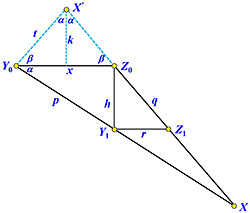
This is the last lecture of this 3-lecture series. Hope you like it and these 3 lectures are helpful. |
The Pythagorean Theorem III | Slides | December 2, 2023 |
Update History